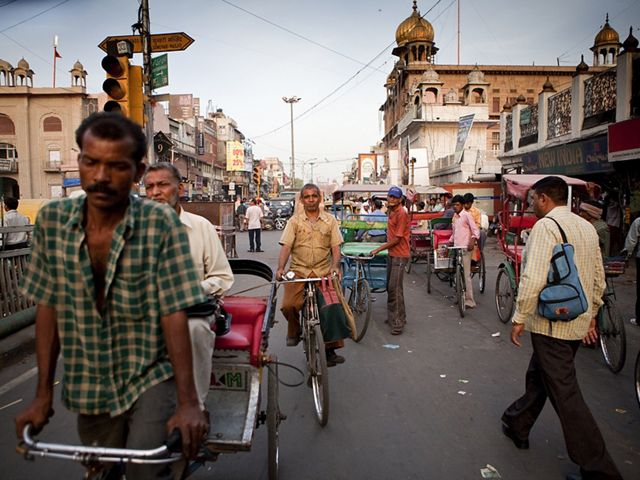On my very first trip to India I experienced some of its most iconic and most infamous sights—tigers and traffic. I was lucky to see some beautiful wildlife, but it was while sitting in traffic that I snapped the photo that most resonated with me: a woman along the road carrying fuel wood on her head. After sitting in traffic for over an hour, our driver decided to backtrack and take a different route; 10 kilometers back, I spotted the same woman still carrying her wood.
This is not, unfortunately, a rare phenomenon—globally, 1.2 billion people are without access to electricity. Almost 300 million of the people in India—a quarter of the population—go without access to electricity, and around 66% (815 million) use wood or other biomass for cooking, the majority of them living in rural areas.
Lack of access to electricity is one of many factors than can ensure that the poor stay poor—and stay sick. Firewood can turn the air inside your home far more toxic than what you’d breathed in an industrial city. The World Health Organization estimates that over 4 million people die prematurely every year from illness attributable to the household air pollution from cooking with wood and other biomass fuels.
This is obviously a global development and human rights issues—but why is this an issue that a biodiversity conservation organization should be concerned with?
By 2050, there will be between two and three billion more people on our planet than there are today, and they will all need food, water and energy. If that energy comes from fossil fuels, it accelerates our already dangerous climate trajectory. Meanwhile, those who still lack access to electricity will continue to turn to readily available fuels like wood, exacerbating unhealthy conditions and contributing to forest degradation—another major source of carbon emissions.
It is imperative that we ramp up renewable energy development in order to expand access while reducing emissions. At the same time, we also have to keep in mind that all forms of energy have tradeoffs. Wind and solar farms have significant land footprints, while the transmission lines required to connect to our power grid can further fragment habitats. If we are not careful, our attempts to meet climate change emission targets and close the energy gap could create a new problem—a pattern of “energy sprawl” that accelerates land-use change and conflict.

What then are we to do?
One option is to curb demand by decoupling economic growth and well-being from cheap energy. This could be done by reducing usage, increasing efficiency and adding new technologies for energy storage and transmission. But even the most optimistic projections of social change and energy innovation cannot halt the short-term need for energy development. For example, India seeks to generate 40% of its power from renewables by 2030, and that cannot be achieved without massive new solar and wind installations.
But we have an opportunity to get this right. In the forthcoming book Energy Sprawl Solutions, my colleagues and I provide a roadmap for a renewable energy future that preserves functional and connected ecosystems. Central to the solution is to get ahead of the problem by sketching out ways to reduce the damaging aspects of energy footprints and to compensate for it in places where it’s inevitable.
For starters, we should try to steer development to occur in already-converted areas, including agricultural lands, industrial areas and former mine sites. To avoid the need for new transmission wires, new wind and solar projects should make the most of existing transmission capacity from nuclear, coal or gas power plants.
We’ll need to work with governments and energy companies to come up with regional energy plans that avoid the most important natural lands. Finally, we need to promote siting energy production as close as possible to the places where it will be used—encouraging development on the very rooftops of the industries and houses where it will be consumed. By helping direct new development toward degraded lands or rooftops, we can safeguard biodiversity, help address climate change and actually speed up the development of renewable energy sources.
This is easier said than done, of course. India seeks to achieve universal energy access by 2030, a goal that the World Resources Institute estimates will require massively scaling up distributed generation— modular systems that generate power close to where it is used, including stand-alone systems as well as mini-grids. With funding recently received from the MacArthur Foundation, we will work in partnership with the Center for Study of Science, Technology and Policy (CSTEP) to help India achieve its goals for renewable capacity and to create an additional carbon sink of 2.5–3 billion tons of CO2 by restoring ~10 million hectares of forest and rehabilitating another 10 million hectares by 2030.
Meeting these goals will also require planning and implementation tools that facilitate development while avoiding impacts to forests. It’s a tall order, but there is reason for optimism. In 2016, India released its draft National Policy on Renewable Energy-based Micro-grids, which will establish at least 10,000 renewable-based micro- and mini-grid projects across the country. This will complement grid access with decentralized, smaller-scale systems that supply electricity directly to consumers.
To that end, we will adapt CSTEP’s computational and visualization platform—Decision Analysis for Research and Planning (DARPAN)—that can simulate and evaluate the economic impact of energy choices based on decision-maker concerns. By incorporating a range of land values (e.g., biodiversity, ecosystem services, social values) we can help policy makers identify locations where renewable energy can be advanced with minimal impacts to forests and people. Hopefully this means more tiger habitat and fewer people carrying firewood.
India is just one country, of course. But if we can get this right, India can show the rest of the developing world how to achieve comprehensive access to affordable energy without compromising on environmental concerns. Given the great need, we can’t afford to get it wrong.


